The Mark Morris Dance Group and Fellows of the Tanglewood Music Festival performs operas by Benjamin Britten and Henry Purcell.
Mark Morris has journeyed into music in other ways beside making dances to compositions he loves. He has conducted orchestras, directed and choreographed operas. Two works presented in Tanglewood’s airy, wooden Seiji Ozawa Hall reveal his sensitivity to music in very diverse ways. He directed Fellows of the Tanglewood Music Center in Benjamin Britten’s Curlew River (A Parable for Church Performance) and remounted his choreographic rendition of Henry Purcell’s opera Dido and Aeneas for members of the Mark Morris Dance Group and Tanglewood musicians.
Voyages are also central to these two superb works by British composers born three centuries apart, and with inevitably dissimilar musical styles. The heroine of Curlew River is coming to the end of a long, sorrowful journey. Purcell’s Aeneas has barely landed in Carthage (after years of wandering, following the fall of Troy) and fallen in love with its queen, when a viciously mischievous sorceress tricks him into setting sail again. Curlew River’s Madwoman finds sanity and a blessing; Dido dies of grief. The visual designs—by Allen Moyer for Curlew River and Christine Van Loon’s costumes and Robert Bordo’s set for Dido and Aeneas— enhance the differences between the works; the costumes and set for the former are all white, for the latter, all black.
William Plomer’s libretto for Curlew River, which premiered in 1964, is a translation of the Noh drama, Sumidagawa by the 15th-century Japanese playwright Juro Motomasa. Britten and Peter Pears (who was to sing the leading role) had been enthralled by the play when they saw it in Tokyo in the mid-1950s. Sumidagawa tells in highly poetic language of a grief-maddened noblewoman who has been searching for her only son, kidnapped at the age of twelve by a slaver.
Like all Noh plays, it is spare, unfolds slowly, and takes place at a moment of revelation and resolution. As a ferryman takes the woman and other passengers cross the Sumida river into the remote lands on the other side, he tells of a sick child-slave, abandoned there by its master, and left to die. A memorial for the boy’s death on this day a year ago is being celebrated on the very shore that the boat is approaching. The heroine gradually realizes that she has found her son—too late to embrace him again.
Britten turned the drama into a Christian parable, embedding it in another dramatic framework. An abbot tells the tale to his assembled monks, as an example of God’s grace. The Madwoman, upon receiving a vision of her son (who is believed to have saintly healing powers by those dwelling near the tomb), recovers her sanity. Plomer changed the place names of the original text to English ones, and the work begins and ends with the monks chanting in Latin. As in Noh drama, all the actor-singers are men, and the musicians (not all men) share the stage with them: Mary Ferrillo (viola), Nate Paer (double bass), Matthew Roitstein (flute and piccolo), Jaclyn Rainey (French horn), James Ritchie (percussion), Annabelle Taubl (harp), and Christina Lalog (organ). Everyone wears white pants and loose, long-sleeved white shirts. Bench-like platforms are painted white or draped in white sheeting.
Morris has directed the eight men in the Chorus (monks, pilgrims to the shrine) to appear as natural as possible. Entering, one or two of them step casually over a platform. They sit in individual ways, some on the floor, and various of them busy themselves with folding sheets of white paper. They fall back at the first appearance of the Madwoman and crowd around her informally. But Morris also has them walk here and there across the stage in a group—in a tide. They perform a strong, simple dance in place that suggests traveling.
The use of props is symbolic, as it is in Noh. What the men are making with the paper turn out to be origami birds that they hold out when the Ferryman (baritone Edward Nelson) and the Madwoman (Isaiah Bell) argue about curlews and their cries; later more paper birds are piled up at the shrine (a platform turned on end). The Madwoman arrives with a white parasol that she not only unfurls to hide behind; several times, she pulses it repeatedly between fully closed and fully opened; it could be her beating heart, her anxious breath. One man steadily wafts a long pole with a white “sail” at its top to indicate the boat trip.
Also as in Noh, the text expands on simple actions and makes them significant. Walking across the stage, the Traveller (David Tinervia) tells of his long journey and announces, “Here is the bank of the Curlew River,/And now I have reached the ferry.”
The music, too, is spare and haunting. Rarely do all the instruments sound at once. Often a single instrument responds to a given vocal utterance. When Isaiah Bell as the Madwoman sinks down by the tomb and sings her agony, flautist Roitstein approaches and echoes in his own way Bell’s quavering tones. Melodies recur on different instruments, sometimes simultaneously but out of synch, producing dissonances that suggest those of Noh music, and Bell’s voice sometimes slides down from the note he has just struck, a dying fall typical of Noh.
The performers are all fine—singing wonderfully and acting with eloquence and restraint. They include Nathan Wyatt as the Leader of the Pilgrims and the Abbot (toward the end, he switches back and forth between the roles) and Daniel Moody, as the dead child’s unseen spirit, whose high countertenor floats with piercing beauty above the voices of the Chorus. Morris has made some sensitively poetic decisions about the Madwoman, and Bell interprets the role remarkably. He sometimes moves with the small, fluid steps of the men playing women in Noh and Kabuki dramas, and he has a delicate way of sinking into himself and averting his gaze. In one striking passage, his lifted parasol carries him staggering backward several times, as if he’s being blown by an emotional wind.
Bell modulates his high, clear tenor beautifully among fading-away grief, imperiousness, and violent despair. The last moment belongs to him. All the other men leave the stage after finishing the plainsong hymn with which they began the piece, “Te lucis ante terminum” (“To thee before the end of day,/ Creator of all things, we implore. . . .”). The bereft mother sits—still, mute, and alone—beside the grave of her son.
For Dido and Aeneas, the singers, the members of the Tanglewood Music Center Orchestra, and conductor Stefan Asbury are stationed on the narrow balcony behind the stage, and dancers enact the roles. Purcell’s music is melodious and harmonic even in some of its darkest moments, such as those in Dido’s final, wrenchingly tragic aria, “When I am laid in earth. . . .” It frolics and skips with Dido’s two handmaidens (Maile Okamura and Rita Donahue), for whom Marie Marquis and Samantha Malk up above the stage sing “Fear no danger to ensue,/The hero loves as well as you.” The lusty and maliciously clownish antics of the Sorceress’s two witches (Noah Vinson and Dallas McMurray), however, are accompanied by a delicious, slightly screechy glee in the voices of Jessica Aszodi and Katherine Maysek.
This Dido and Aeneas, created by Morris in 1989, also plays with gender roles. All the dancers wear the same sleeveless, formfitting black tops and long, draped sarongs, except for Aeneas (danced by Spencer Ramirez and sung by Steven Eddy), who appears bare-chested. In the work’s premiere at the Théatre de la Monnaie in Brussels, and later at the Brooklyn Academy of Music, Morris himself played both Dido and the Sorceress. Unforgettably. Only a change from caught-back curls to a wild mop of hair altered his superficial appearance, but, of course, the change in movement from heartfelt love and dignified sorrow to demented hatred was remarkable. At a later performance, a woman (Amber Star Merkens) played Dido, and a man (Bradon McDonald) took on the Sorceress. At Seiji Ozawa Hall, Laurel Lynch essayed both, and was marvelous.
She might have studied Morris, so gloatingly wicked is her Sorceress. She brings out the voluptuous pleasure brought on by the contemplation of Dido’s downfall, as well as ho-hum boredom when her athletically demonic assistants carry on too long. This tragedy is full of comedic touches—in Purcell’s music, Nahum Tate’s libretto, and Morris’s choreography. Consider the rollicking sailors, led by Lauren Grant (the smallest woman in the company), who orders them to “take a boozy short leave of your nymphs on the shore.” Perhaps the funniest scene is one in which the assembled witches enact, one couple after another, various raunchy split-second versions of Dido and Aeneas’s coupling and forthcoming separation. How turned-on—“ho, ho, ho” —they are by their nastiness, as the chorus above them sings, “Destruction’s our delight!” And, with a quick adjustment to her hair and decorum, the Sorceress becomes Dido, and singer Samantha Malk prepares her voice for resignation and lament.
The performers in this work not only dance in the usual sense of the term; they often mime the words being sung or express the emotions in gestures and positions. It’s especially moving to be able to see both the singers and the dancers at the same time; they merge into a supremely eloquent whole.
A marvelous evening. I wish I could see it again this very minute.

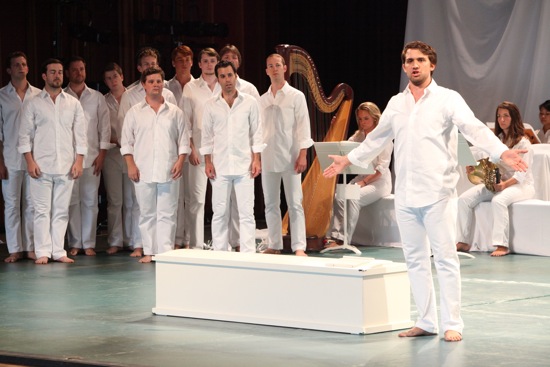
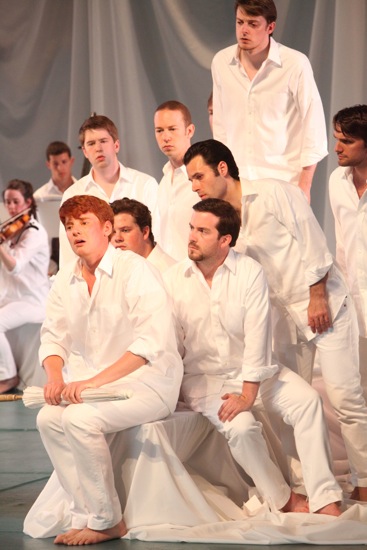
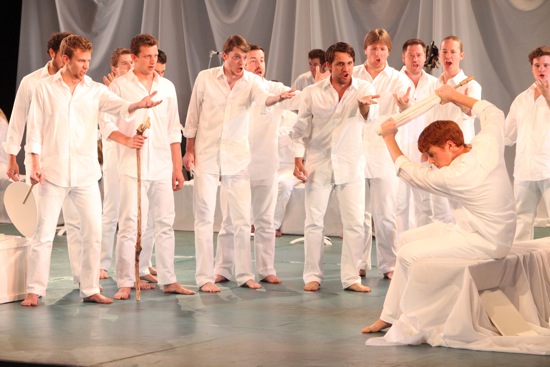
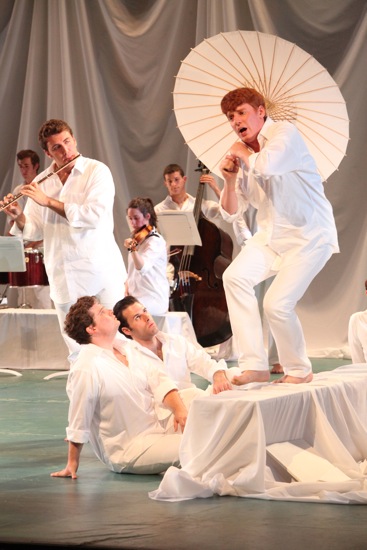
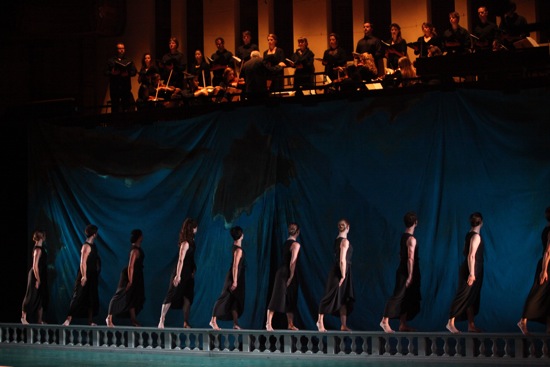

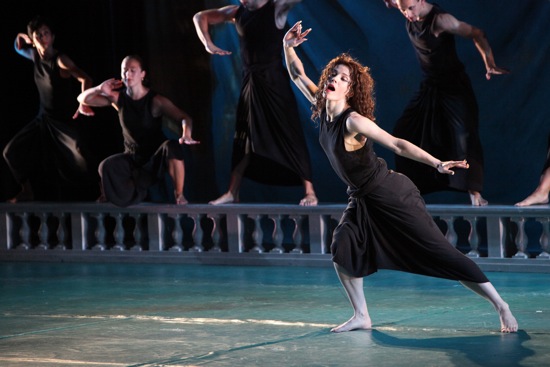
I’m a jealous wreck, that’s what I am, but thank you Deborah for so eloquently putting me in the picture, as British intelligence might say.
I, too, wish I had seen these two productions. In June, to my delight, I attended the premiere of Mark Morris’ ‘Rite of Spring’ at UC Berkeley under the auspices of Ojai North. It was marvelous and damn good!
“A marvelous evening. I wish I could see it again this very minute.”
I’m sure we all wish we could see it.
Many thanks for sharing your neat internet site.